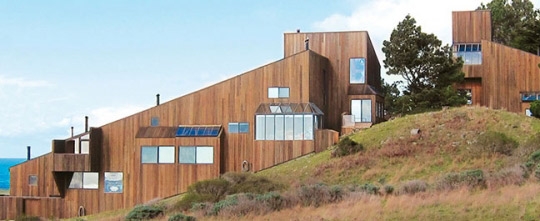Why Charles Moore (Still) Matters
Why Charles Moore (Still) Matters

On the occasion of the forthcoming 50th anniversary of the first designs for the Sea Ranch, Metropolis Magazine asked several of Charles Moore's longtime partners to briefly reflect on working with Charles and his importance to the field. Here are some thoughts shared by Buzz Yudell and John Ruble:
Buzz Yudell:
When Charles Moore arrived in New Haven to become the youngest Dean in the school's history, it was like a fresh, invigorating breeze from the west. He had recently completed the Sea Ranch Condominiums with MLTW and Lawrence Halprin, as well as some extraordinarily inventive, yet modest houses.
Charles swept in with an array of initiatives that were avatars of progressive thinking and values. He focused on planning and building for the less enfranchised with an interest in affordable housing and the establishment of the First Year Building Project. The latter involved designing collaboratively for non-profit groups who otherwise would not be able to afford design services, much less a building. During the summer, all first year students worked on site with real clients, real material and hands on construction. It has been a transformative experience for generations as well as the inspiration for other great programs such as the Rural Studio.
Charles constantly talked about the importance of "making things" with your own hands. He was complemented in this with the inspiration of Kent Bloomer, a sculptor, writer and great teacher.
He was an early supporter of environmentally based planning and design, an advocate of community involvement and had a healthy skepticism of the influence of those in power.
He was ahead of his time in numerous ways including his advocacy of cross disciplinary work, his belief in team based projects, his interest in literally all the cultures of the world.
His great knowledge of the history of the art and architecture of the world and his openness to "high" and "low" art, combined with his irreverence and wit; encouraging all to break taboos, to use "cheap" materials, to experiment, to be inclusive.
This is partly responsible for the facile stereotype of Charles as a sometimes promiscuous Post-modernist.
But for those who worked closely with Charles, we know him as a disciplined, rigorous designer, wrapped in a puckish irreverent personality. He had an extraordinary spatial imagination, encyclopedic knowledge, lightning fast comprehension and most importantly an unshakable belief in architecture as a celebration of the individual, the community and the place.
He drew clients, friends, colleagues into a magic realm of collaboration, powered by a sense of wonder about the world and an unflagging optimism about the ways in which architecture can ennoble our lives.
In short, his commitment to architecture as an inclusive and humanist art was profound and irresistible. It inspires us and reverberates every day.
John Ruble:
Re-discovering Charles Moore may remind contemporary students and practitioners that architecture achieves its greatest relevance and meaning in relation to place and culture. Because we live in an instantaneous, ubiquitous culture of communication—evidenced by a globally influenced contemporary architecture—those who are growing up in a digital society can benefit by getting out and seeing real places—settings that are the result of cultural differences—discrete, particular, and deeply rooted in specific human histories.
Charles’ writing about the experience of architecture and culture is an entire legacy in itself. My personal favorite among Charles' writings is The Poetics of Gardens, written with William Mitchell, with wonderful drawings by Bill Turnbull and lots of others. It brought together a large group of friends in its production, and takes the reader on a tour of great world landscapes, with an intimate education on how to see such places.
Travelling, seeking out profound experiences of place and time, was and is an integral part of a Moore partnership. As many liked to remind us, Charles’ continuous flying here and there became a bit notorious as well: fly in, set the agenda, fly off, fly back in, change it all around, fly off again, return and repeat—so the story went. Sounds difficult for the partners who stay in the office, but what made it worthwhile is the virtue of perspective in that process. We began to do more of the flying ourselves, and the experience of the different places, sites, projects, and even clients tends to cross-inform, and enrich and liberate the thinking. Over the long term, it’s having that diversity of practice, experience, and expertise that distinguishes our firm and culture.

In a rare opportunity for direct engagement with Charles Moore’s built legacy, we are now working on one of the most remarkable of the MLTW projects, the Faculty Club at UC Santa Barbara. Dating from 1968, it was a restless, in-progress design, with more than enough iconic presence for several buildings, all stirred into an engine of gesture and movement and light. Dirt cheap and ultimately not very flexible as a faculty club, it fell into abject disrepair.
We are taking three approaches at once: restoration, adaptive re-use, and additive transformation. The biggest challenge is the indoor-outdoor treatment of the many layers of walls, wood trusses, and stucco details. We are using new roofs with a lot of skylights to enclose the layers of walls and spaces, so the complexity of construction will be animated by the sun but protected from the weather. An outdoor courtyard that was cold and damp in Santa Barbara's coastal climate will become a multi-event hall. That and 30 new guest rooms will totally transform the economics of the club and give it a new lease on life.

